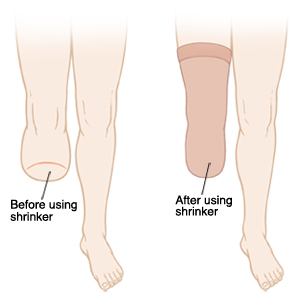Preparing Your Residual Limb for a Prosthesis
Part of your rehabilitation will be working with your healthcare team to prepare you for your prosthesis. Your team will tell you when you're ready to be fitted for your prosthesis. Talk with them about which prosthetic devices might be best for you.
Prosthetic fitting starts when the stitches or staples have come out, the surgical wound has healed, your pain is managed, and your rehab continues. Now you can start to get your residual limb ready for a prosthesis. During this time, keep these goals in mind:
-
Correct positioning of your residual limb
-
Muscle stretching and strengthening
-
Touch and desensitization
-
Residual limb shaping
-
Daily limb care and hygiene
Residual limb positioning
Keeping your residual limb in the right position is vital. This helps prevent muscle shortening and tightening (contracture), which prevents full range of motion. To prevent contracture, you’ll need to keep your knee and hip as straight as you can. Here’s how to do this:
-
When seated, always support your residual limb to keep it from dangling or hanging. When sitting in a wheelchair or a regular chair, you can use an amputee board. This is a flat board that sticks out to support the weight of your residual limb.
-
Spend time every day lying flat on your stomach (proning). Proning stretches the muscles at the front of your hip. These muscles get tight when you sit. It’s important to spend 15 to 20 minutes proning several times a day.
-
Don’t prop your residual limb on pillows or blankets when you sit or lie down. Keep your residual limb flat, with your knee as straight as you can.
-
If the amputation is above the knee, keep your residual limb close to the intact leg. Allowing it to move outward may make it hard to walk with a prosthesis later.
Stretching and strengthening
You need to keep the muscles in your residual limb strong and limber. Work with your rehab team to keep doing the exercises you were taught in the hospital. This will help prevent contracture. It also ensures that your intact limb and residual limb are strong and flexible. Both legs need to be strong to walk with a prosthesis.
Touch and desensitization
At first, the skin on your residual limb will be sensitive to touch. Desensitization can help. This involves massaging, rubbing, and tapping the end of your residual limb. Start with a light, gentle touch. As your tolerance improves, slowly increase pressure. This helps get you ready for your first prosthesis fitting.
Residual limb shaping
 |
| Wear your shrinker sock at all times to reduce swelling. This helps shape your limb for wearing a prosthesis. |
Even after the surgical wound has healed, your residual limb can still be swollen. Swelling must be reduced so your residual limb will fit into the socket of a prosthesis. This process is called shaping the residual limb. Your healthcare provider will prescribe a compression stocking to shape your residual limb.
Remember:
-
Wear the compression stocking (shrinker sock). This is a tapered sock that applies even pressure to the bottom of the residual limb. Pressure helps reduce swelling.
-
Wear the shrinker sock as close to 24 hours a day as possible (except when bathing). Keep it pulled tight to have a snug fit at all times.
-
See your prosthetist as directed. They'll monitor the changing size of your limb through the entire fitting process. This helps to ensure the prosthesis fits correctly.
Daily limb care and hygiene
Keeping your residual limb clean is vital to prevent skin problems and infection. Do the following every day:
-
Wash your residual limb at least once a day. Use clean, running water and a mild antibacterial soap.
-
Using a washcloth, scrub gently over all surfaces of the residual limb. Pay close attention to the skin behind your knee and on the bottom of your limb.
-
Dry your residual limb thoroughly. This keeps moisture from being trapped between your skin and the shrinker sock.
-
Wear a clean shrinker sock every day. Wash each sock with mild soap and water, rinse well, and air dry completely. This removes salts and acids left by your sweat.
When to call the healthcare provider
Inspect your residual limb daily, especially the skin of the surgical scar. Use a mirror to check the back of your limb. Or ask a family member or friend to help. Call your healthcare provider right away if you notice any of the following:
-
Skin separation along the surgical scar
-
Scar or residual limb has a bad smell
-
Area around the scar is warm or hot, or gets red or swollen
-
Pus or yellow fluid leaking from the scar, or thick discharge that is brownish gray
-
Sudden increase in pain or severe tenderness
-
Fever of 100.4° F ( 38.0°C) or higher, or as advised by your provider
-
Chills